Abstract
Sustainability is one of the current much-discussed issues in the world, including in tourism sectors. However, there are few studies on tourism management and marketing toward sustainable tourism. This study aims to analyze the literature on tourism management and marketing toward sustainable tourism by using a bibliometric analysis approach based on the Web of Science (WOS) database. A sample of 528 articles was analyzed in this study. The data were processed and the results were graphically presented by using the R program. The results found the occurrence of publications by year, publication source information and authors, journals, countries, institutions, thematic maps, and current trends of topics in tourism management and marketing toward sustainable tourism. Furthermore, the role of tourism management and marketing toward sustainable tourism were discussed in this study. The bibliometric analysis helps to identify a future research agenda in sustainable tourism.
1. Introduction
The sustainability issue refers to environmental challenges, such as water and air pollution, climate change, and biodiversity, and these agendas should be addressed in terms of sustainable development [1,2]. The economic growth of each country has had an impact in all sectors, including in the environmental field [2,3,4]. Sustainability is one of the worldwide issues for developing and developed countries, due to economic growth. Economic growth can impact the environmental field, and natural sources are under pressure due to economic issues, such as increasing consumption rates or economic development. Recently, the sustainability issue has gained weight in business development and has aroused interest in the scholarly community in the theoretical and research areas [5].
Sustainability is the main issue in the tourism sector. Regarding sustainable development, the tourism destination must care about the environment and the continuity of natural sources while guaranteeing economic development [6,7,8]. Hence, in the tourism sector, the environment and sustainability are becoming essential topics for academics and researchers and are becoming the trending topic for research [9,10]. For tourism stakeholders such as tourist organizations, the government, and tourism marketers, the concept of sustainability is not only about the competitive advantages but also refers to the continuity of the development of critical sources for marketing and business [10,11,12].
Many researchers have been interested in conducting studies related to sustainability and tourism research [7,8,9,12,13] due to the need for a sustainable environment and the preservation of nature and other facilities [13]. The tourism sector is a sector that creates job opportunities and economic/business growth in each country [14]. Therefore, the world’s challenge is to balance tourism with sustainable development [1]. The form the role of sustainability takes in the tourism field is essential for strategy in the marketing and management of tourism destinations [15]. Many studies have discussed the relationship between sustainability and tourism destination, and marketing and image/branding [2,11,16]. Sustainable tourism is a solution to increase the economic productivity of society, have a positive influence on nature, and provide a positive perception between visitors and local groups regarding social and cultural sustainability [17,18]. The study of sustainable tourism has been conducted by several authors [7,8,9,12,13]. However, there are few studies that have been conducted by using systematic reviews on the topic of tourism management and marketing toward sustainable tourism in one framework.
Therefore, to reach the purposes of the study, this study attempts to answer the research questions (RQ): RQ1. What is the role of tourism management and marketing toward sustainable tourism? RQ2. What is the critical theme in research related to tourism management and marketing toward sustainable tourism from the past to the present? RQ3. What is the trending topic for future research in tourism management and marketing for sustainable tourism that may be recommended to researchers regarding this issue?
This study proposes to analyze the role of tourism management and marketing toward sustainable tourism and current trends, then analyze the future research agenda by using the bibliometric analysis approach. This analysis provides the result of the study in tourism management and marketing toward sustainable tourism. It defines the concept of management and marketing in sustainable tourism by mapping the literature through bibliometric analysis, finding the authors, journals, and thematic topics/issues, and explaining the role of tourism management and marketing toward sustainable tourism. From the perspective of the stakeholders or managers, this study gives an understanding of the emergence of management and marketing for sustainable tourism. It is urgent that the concept of sustainability can be applied to the analysis of the tourism sector to give non-stop drive in the business area. Therefore, it is important to understand how management and marketing are applied to sustainable tourism, such as the role of managers, government, and policymakers. Thus, the study encourages the stakeholders or marketers in tourism to consider the management and marketing aspects toward sustainable tourism.
One of the concepts in sustainable tourism management is sustainable tourism destinations. The sustainable management of destinations includes business aspects, such as companies, local regulations, and organizations. Sustainable tourism management emerges to develop the concept of tourism in a sustainable manner [19]. In the management and tourism field, the individual, private company, government, and all the agencies have an urgent role in achieving the conservation of natural resources, the development of regions or areas, and the protection of areas of cultural significance when sustainability is the main concern [20]. Another concept that can be applied to tourism management is stakeholder theory. Stakeholder theory can contribute to sustainable tourism and has been applied in this study. A stakeholder is the group or individual who can give the impact or be impacted by the result of the organization’s purposes [21]. In the context of the tourism field, the stakeholder theory is concerned with the notion that organizations and locations are motivated by the desire to create value [22,23].
Marketing is the management process from which the customers obtain some benefits, such as identification and satisfaction with products or services [24]. Tourism marketing is one of the elements in the tourism sector that through strategy and communication promote tourism branding, allowing profit to be made [25]. Sustainability marketing aims to illustrate caring in tourism products and enhance sustainable tourism products, therefore further promoting the behavior of consumers toward consuming sustainable tourism products [26,27,28]. Sustainability in destination marketing is one factor that creates beneficial competitive advantages, and is an important reference for consumers to make their decisions [29,30]. Furthermore, sustainability marketing in tourism has an urgent role in encouraging the consumer, applying sustainable practice, and encouraging tourist behavior toward the use and practice of the sustainable product [31].
The construct of sustainable tourism is derived from sustainability and tourism theory. Sustainability refers to “the concept with the power” [32]. Authors have defined the concept of sustainable tourism with several concepts such as open interpretation [33], and multi-terms such as ideology, philosophy, concept, the process, or even the result or product [34]. Based on reference [33], it shows that the meaning of sustainable tourism refers not to the mix of economic, environmental, and cultural components into tourism’s form, but how to mix the components of mass tourism development as sustainably as possible. Therefore, sustainable tourism is a concept for the tourism system to consider ecological or environmental impact [35]. The tourism sector is one of the leaders in the economic aspect. Sustainable tourism is broadened to become sustainable development, which focusses on the needs for the future and integrates environmental components, social–economic welfare [36], or the triple-component bottom of sustainable tourism. Sustainability refers to economic, social, and environmental elements that are connected to the concept of the tourism sector.
In the following section, the methodology is explained, referring to bibliometric analysis and data sources. The results are explained in Section 3. Section 4 is the discussion section. In Section 5, the last section, the conclusion, limitations, and future research agendas and directions are suggested.
2. Methods and Materials
2.1. Data Analysis
Bibliometric analysis has been applied to the research as an approach to analyzing scientific documents, such as the management field in manufacturing [37], sustainability [38], and the tourism sector [39]. In the scientific paper, bibliometric analysis has been often used, such as in co-citation analysis, bibliometric coupling, word analysis, cluster analysis, and co-authorship analysis [37,40]. The process of data analysis using bibliometrics is explained in Figure 1.
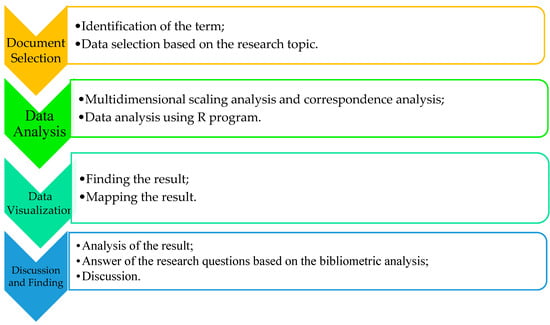
Figure 1.
Data analysis process.
Based on the aim of this study, the following analyses are used. In this study, there are several ways to analyze, such as annual scientific production, publication sources information and most-contributing authors, the institution distribution of research, and geographic scientific production. The results obtained from these analyses allows us to find the state of the development and trends based on the journals, articles, institutions, countries, and keywords within the scope of management and marketing in sustainable tourism.
Software is the main tool to analyze scientific documents; it is the tool that can be used in identifying research questions, analyzing visual data, and disseminating knowledge [41]. There are several tools that can be used in analyzing data for bibliometric analysis, such as VOSviewer [42], CiteSpace [43], SciMAT [44], CitNetExplorer [45], BibExcel [46], e Sci2Tool [47], and R program [48]. In R program for scientific mapping, in this study, we used visualize map to find the scientific map; we used the ‘Bibliometric’ package (http://www.bibliometrix.org accessed on 10 January 2022) to find the bibliometric analysis found by reference [48] in R language (statistical program). In this study, the R program’s bibliometrics analysis is the familiar software and covers the features in publications [49,50]. Furthermore, the study results are analyzed using multidimensional scaling analysis and correspondence analysis [51].
2.2. Journal Selection
This study is based on the bibliometric analysis of management and marketing in sustainable tourism with three major steps: planning, conducting, and providing results. The bibliometric analysis gives an overview and knowledge of the state of the art in the researched topic that has been published in the journal [52]. This method generally explains published document categories in each area based on the objective for analyzing and classifying publications [15].
The study uses the bibliometric approach to analyze and answer the research questions based on the Web of Science (W0S) database. In addition, the Web of Science (WOS) covers more than 161 million recorded documents and 254 subject areas [53]. To find the bibliometric and obtain the scientific documents published in this study, we used the WOS database to find the focus research. We used the keyword search strings to obtain the bibliometric information from the WOS database based on the topic through the keywords: “tourism management” AND “tourism marketing” AND “sustainable tourism”. The results reveal that the documents are identified in the Web of Science database using a keyword or search key depending on the study subject, including title, abstract, and the keywords of the paper, including “Tourism Management” AND “Tourism Marketing” AND “Sustainable Tourism”, considering peer-reviewed journals written in English. The number of documents in this study is 528 scientific documents in several document types, such as articles, proceedings papers, editorial materials, and review documents. The authors conducted the documents or papers search in January 2022.
3. Result and Discussion
3.1. Trend Publication and Main Information
The descriptive information explains the sample of scientific information in this study. After the searching process for the main topic of the research, Table 1 explains the publications’ primary information on tourism management and tourism marketing in sustainable tourism. In this study, the number of documents related to the topic is 528 scientific documents, including articles, conference papers, and article reviews. From Table 1, we can conclude that the topics in this study are from 1992 to 2021. Moreover, the trend number of publications in this research topic significantly increased from early 1992 to 2021. From Figure 2, we can conclude that the highest number of publications related to tourism sustainability is in the year 2021, with 104 publications.

Table 1.
Main information of the data.
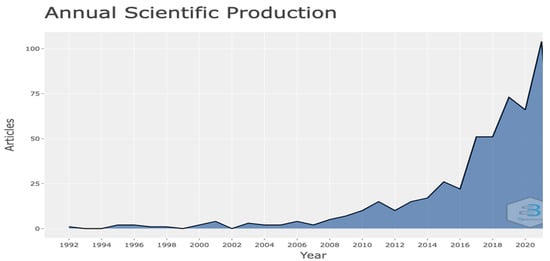
Figure 2.
Annual scientific publication.
Furthermore, in this study, the total of 1527 authors have published on management and marketing in regard to sustainable tourism, including articles, article reviews, conferences papers, and editorial materials. In the next section, the results in this study explain the mapping of the research topic characteristics to cover the preliminary information in this area of the study.
3.2. Publication Sources Information and Most-Contributing Authors
Figure 3 uses Bradford’s law. Bradford’s law explains how the articles in the field are spread across journals, and the majority of the articles in the area are centered based on core journals [54]. The results show a large number of journals that are published with few documents [55]. As shown in Figure 3, Bradford’s law explained that the core journals that have been published in sustainable tourism, such as the Sustainability Journal, Journal of Sustainable Tourism, Tourism Management, and the Journal of the Destination Marketing and Management are the main journals in sustainable tourism. Furthermore, Figure 4 explains Lotka’s law analysis for the distribution of the journals. Lotka’s law analysis is the frequency of the journal or the documents written by the authors, based on the focus of the study [56]. From Figure 4, we can conclude the results of the study, which had many authors, with around 1443 authors having only one document written, which accounts for 94.5% of the total contributions of the authors.
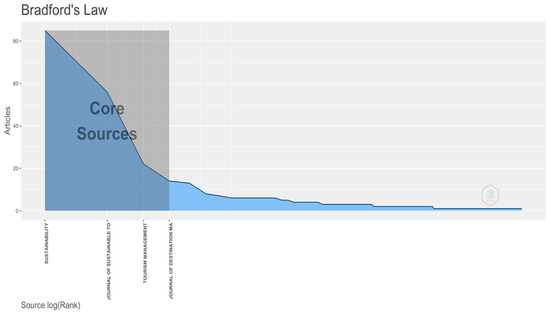
Figure 3.
Bradford’s law.
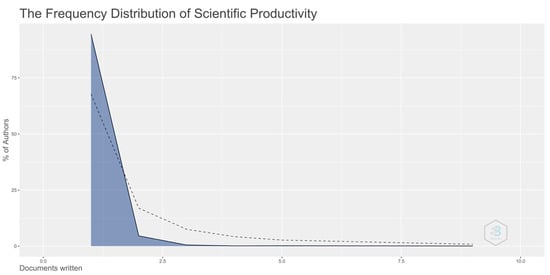
Figure 4.
Frequency distribution by Lotka’s law.
Figure 5 shows the 10 authors’ productions in the papers based on the research topic in tourism management and marketing in sustainable tourism. The results show that Hall, C.M. is the most popular production from 2013 to 2021. The second most popular production in the research topic is Campon-Cerro, A.M. between 2017 and 2019. The third most popular author is Dwyer, L. in 2013 and from 2016 to 2019. The fourth most popular is Hernandez-Mogollon, J.M., and the fifth most popular is Folgado-Fernandez, J.A.
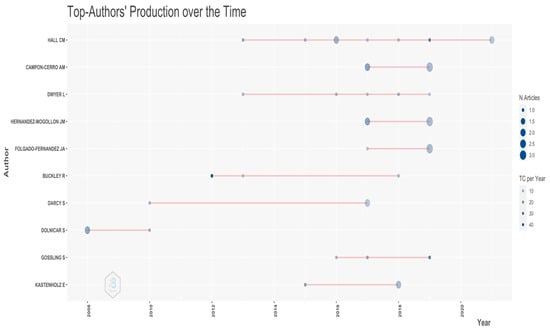
Figure 5.
The authors’ productions over time (2008–2021).
Furthermore, Figure 6 explains the corresponding author’s country; the result of the graph shows some countries that produced the highest amounts of scientific documents in sustainable tourism based on multiple country publications (MCP), such as China, Australia, and the United States of America (USA). For single country production (SCP) in this study, it was China, Spain, and Australia. These are the countries who most influenced the research topic in tourism management and tourism marketing in sustainable tourism.
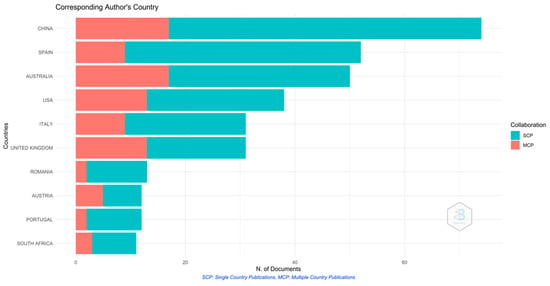
Figure 6.
The most corresponding author’s country.
3.3. The Institutional and Geographic Scientific Production
Figure 7 explains the distribution of scientific documents by institutions or affiliations. The result shows that 10 universities published the most in the field of study. The first-placed is an Australian university, which has the leading institution in publishing scientific documents on marketing, management, and sustainable tourism, namely Griffith University, with 25 document articles. The University of Extremadura from Spain is the second most represented affiliation in publishing scientific documents, with 14 articles. In addition, there are universities such as the University of Canterbury in New Zealand and South Johannesburg University in South Africa, which are institutions that published 10 articles. Fujian and Forestry University in China, University Oulu in Finland, and Canada University Waterloo in Canada had 8 publications. The last institutions that published articles in sustainable tourism related to management and marketing are Harran University in Turkey, University La Laguna in Spain, and University Las Palmas Gran Canaria in Spain, with seven publications.
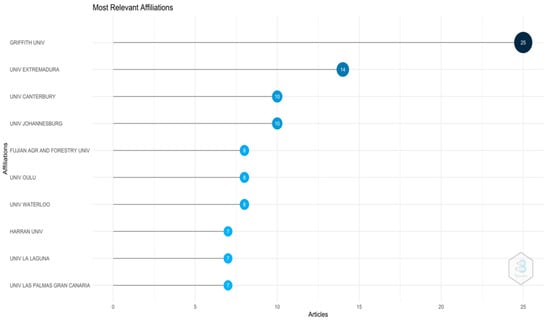
Figure 7.
The most relevant affiliations.
Furthermore, the global distribution of sustainable tourism papers is presented in Figure 8. The research on tourism management and marketing in sustainable tourism output is widely distributed worldwide. The color trends have represented the countries according to the number of publications that have been published. Based on Figure 8, the documents are provided by 10 countries with the most contributions of scientific documents. The most productive country is China, which covers 192 document papers. Spain follows it with 105 documents and Australia with 101 documents. The United States of America is the fourth-highest country, covering 97 documents. The following country is the United Kingdom with 63 documents, then Italy with 62 documents, South Africa with 39 documents, and Portugal with 27 documents. In addition, Canada published 26 documents and Romania published 22 scientific documents.
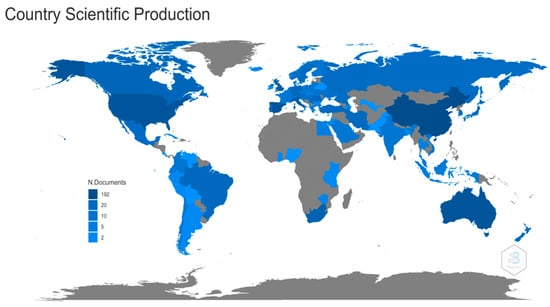
Figure 8.
Scientific production by country.
3.4. Thematic Issues and Trend Topics
This part explains the keywords used by the authors related to research focused on sustainable tourism. The authors provide statistical analysis to examine the keywords [57]. This part also provides some of the authors’ perspectives on the cluster based on the treemap.
Figure 9 shows the treemap used in this study by the authors. The result shows that the authors used keywords to represent the size of the word in the abstract of the papers. The more significantly sized words are representative of the frequency that the word is used by authors in the abstract. From Figure 9, we can conclude that the term “management” is the most considerable size in this study, and the frequency of the term is 155 or 14%. It means that the authors used it as the most frequent term for sustainable tourism.
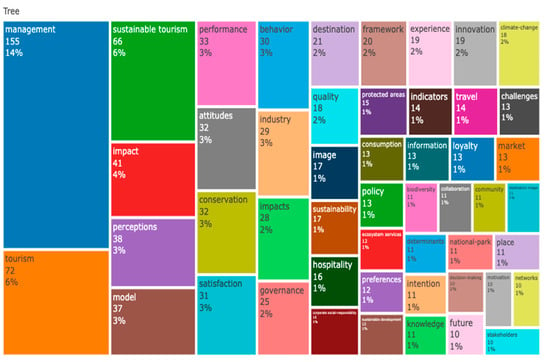
Figure 9.
Treemap analysis.
Furthermore, the authors used the word “tourism” in the papers as many as 72 times (6%). In addition, the third position in the treemap is the word “impact”, with a frequency of 41 (4%). The overall result of the word cloud can be seen in Figure 9, which explains what words the authors used in their papers based on the treemap.
This section provides some of the trend topics in tourism management and tourism marketing toward sustainable tourism. Figure 10 explains the trend topics from 2008 to 2021 in sustainable tourism. The topics are different year by year. The trend topics such as the word “management” are the most frequently used by authors from 2017 to 2021, with 155 instances. The authors covered the second trend topic, the “tourism” topics, with a frequency of 72 from 2016 to 2020. In addition, the term “sustainable tourism” was used to cover the research topic in sustainable tourism with a frequency of 66. However, in 2021 some of the trend topics covered by the authors are “decision making”, “growth”, “word of mouth”, “evolution”, and “attributes”.

Figure 10.
Trend topics.
Figure 11 shows the results of the co-occurrence of the keywords. The weight of the keywords is represented by the node and word sizes. The findings reveal that terms are confined to a minimum of 50 occurrences, with three clusters. The term “management” is the most prominent node in cluster one or the red cluster, and it appears in about half of the publications in our database. Tourism is the second most significant word in the red cluster or cluster one.
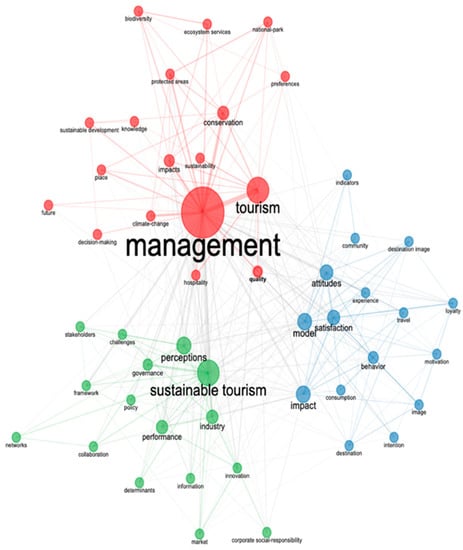
Figure 11.
Co-word network analysis.
Furthermore, words such as “conservation”, “impacts”, “climate change”, and “quality” are keywords that have appeared in the red cluster. The second cluster is a blue color. The most powerful word in this cluster is the word “impact”. In addition, some words such as “model”, “attitude”, “satisfaction”, and “behavior” are representative of the words in the blue cluster or the second cluster. The last cluster in this section is cluster three or the green cluster. The biggest word in this cluster is “sustainable tourism”. In addition, some other words also represented in this cluster, such as “perceptions”, “performance”, “industry”, “governance”, and “framework”.
Figure 12 presents the thematic evolution of the papers from 1992 to 2021. From the figure, we can conclude that the thematic evolution of the papers is divided into three periods. In the first period from 1992 to 2017, the thematic evolution is covered by “tool”, “management”, “impact”, “cluster”, “sustainable tourism”, “industry”, “behavior”, “travel”, “model”, and “attitude”. The second thematic evolution period is from 2018 to 2020, and in this period the thematic evolution is covered by themes such as “satisfaction”, “management”, “sustainable tourism”, “innovation”, “perceptions”, and “quality”. The last thematic evolution in 2021, and the thematic evolution is covered by words such as “ecosystem services”, “model”, “sustainable tourism”, “tourism”, “impacts”, “behavior”, “conservation”, “management”, “decision making”, and “green”.
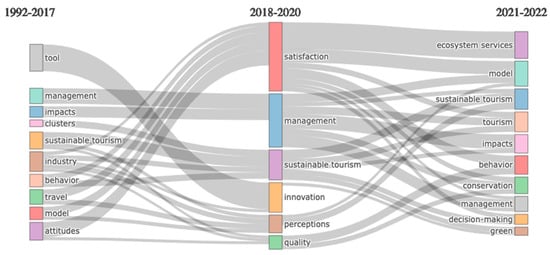
Figure 12.
Thematic evolution.
Furthermore, in this study, the authors use a multidimensional scaling analysis. According to reference [58], multidimensional scaling analysis is an exploratory approach for reducing multidimensional space search variables into two-dimensional space for object localization, analysis, and categorization. The term distribution in points may be seen in the graph. The similarity between the keywords is shown in the location of each term. The grouping of the items is influenced by the similarity of the keywords. The closer among the keywords to the center of the cluster and the more central of the word is, the more urgent it is [59].
Figure 13 shows the multidimensional scaling analysis with the multiple correspondence analysis (MCA), which is applied in this study to analyze the conceptual structure map. Therefore, in this study, the authors have found two clusters in the analysis. The red cluster shows that the central word in this cluster is “tourism”, which emphasizes the research interest. In addition, the study also highlights other aspects, such as community and sustainability. The red cluster result emphasizes the importance of the community in building the tourism sector toward sustainable tourism.
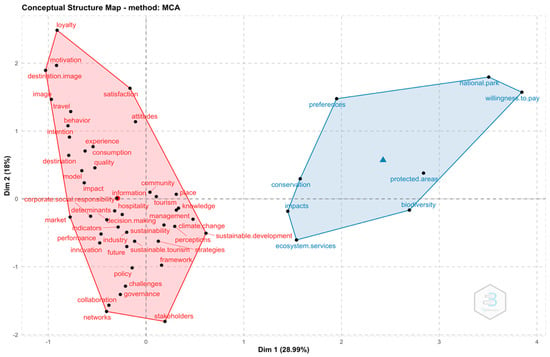
Figure 13.
Multidimensional scaling analysis.
In addition, the second cluster is the blue cluster. The central word in the blue cluster is “preferences” in sustainable tourism. The tourism sector needs more preference in building sustainable tourism, such as conservation and protected areas, which have been mentioned in this cluster. Therefore, the blue cluster also emphasizes that the national park is the object of sustainable tourism in this cluster.
4. Discussion
The study attempts to analyze the role of tourism management and marketing research in the context of sustainable tourism by using bibliometric analysis. It tries to answer the research questions arranged previously in this study. It identifies areas such as the authors and institutions that have published the most, the most specialized journals in the area of tourism management and marketing in sustainable tourism, the topic’s trend from the earlier papers that were published, a network analysis of the keywords, and a collaboration map among authors and documents around the world. Based on these results, it is urgent to identify the research gaps and find the research trend for a future research agenda.
As the role of tourism management and marketing toward sustainable tourism in this study has found, in the context of tourism management, it is a related process to manage actors such as destination management organizations, stakeholders, tourism policy-makers, and communities. The role of management toward sustainable tourism has demonstrated the capability to promote social integration, protect natural and cultural heritage, conserve biodiversity, and improve human welfare. These roles can be achieved through the management aspect. The role of the management aspect or stakeholders is to create sustainable tourism products through policy with local governance, sharing knowledge of sustainable concepts and local habitats or cultures on various aspects of a tourism destination [60,61,62]. It has been noticed that sustainable tourism is reacting to the demands for more responsible policies and forms of corporate governance in the industry, which include stakeholder participation in the processes [33,63]. In addition, the role of government in creating policy for sustainable tourism is essential for innovation and best practice in applying the concept of sustainable tourism [60]. The sustainable approach in the tourism sector can bring together nature and the environment to enhance the impact on development and its maintenance in relation to nature [17,64], and the concept of sustainability can enhance welfare for society and the destination, helping to protect nature for the wellbeing of the Earth’s population [65,66].
The role of marketing toward sustainable tourism is to promote sustainable tourism in several ways, such as using social media or digital media, which can impact the behavior of visitors [67]. The role of digital media in shaping the destination gives opportunities not only to the marketing aspect but also to the visitor in conducting the data [68,69]. The application of digitalization in sustainable tourism is the best way to develop tourism destinations, especially for those who can benefit from information and technology access and infrastructure, helping to conserve resources in tourism destinations [68,70]. In addition, in this study, several keywords have appeared in the context of marketing, such as word of mouth and satisfaction. Word of mouth is the way to promote the product and services, to raise awareness, and enhance demand in the context of sustainable tourism; therefore, promotion is important for making sustainable consumer behavior [26,27,28]. The factors in making consumer decisions and marketing tourism in sustainable tourism can be one of the ways to ensure a competitive advantage for the tourism sector [29,30]. Therefore, marketing in sustainable tourism has the potential to encourage visitors or consumers to adopt the concept of sustainable behavior [31]. Furthermore, the role of marketing toward sustainable tourism gives an understanding of the concept of sustainability for the customers or visitors in the tourism field [20].
This section is to answer the second research question and refers to critical thematic analyses from the past until the present. In Figure 13, the critical thematic evolution in tourism management and marketing toward sustainable tourism is divided into three periods, from 1992 to 2021. In the first period from 1992 to 2017, several thematic evolution keywords were discussed by the authors, such as tool, management, impact, cluster, sustainable tourism, industry, behavior, travel, model, and attitude. In the second period from 2018 to 2020, several thematic evolutions appeared, such as in the themes of satisfaction, management, sustainable tourism, innovation, perceptions, and quality. The last thematic evolution in 2021 is covered by thematic evolutions such as ecosystem services, models, sustainable tourism, tourism, impacts, behaviors, conservation, management, decision making, and green.
For the third research question, Figure 11 explains the trend topics from 2008 to 2021 in tourism management and marketing toward sustainable tourism for a future research agenda. The topics are different year by year and were used by authors based on the keyword analysis. Several trend topics that were used by the authors such as the word “management” are the most frequently used term used by authors from 2017 to 2021. The authors covered the second most popular trend topic, “tourism”, from 2016 to 2020. In addition, the term “sustainable tourism” was used to cover the research topic in sustainable tourism. Furthermore, in the year of 2021, some of the trend topics that are covered by the authors include the words “decision making”, “growth”, “word of mouth”, “evolution”, and “attributes”. These trend topics in the future of research in sustainable tourism may still appear because the issue of sustainability will continue to gain attention from the stakeholders in the tourism sector.
Perceived sustainability, with its social–economic, environmental, and cultural dimensions, can be qualifiers that filter the sort of tourism performed and aid in raising consumer awareness of how tourist products and services are used. They can also support the improvement of public control mechanisms over companies and public policies to enhance the adoption of sustainable practices on both supply and demand sides [71]. As stated by various studies [2,72], it is critical to incorporate all stakeholders involved in creating sustainable practices, including both guests and local inhabitants, in addition to government agents and commercial service providers. Moreover, the word “climate change” has recently appeared among the terms in the keywords. Tourism significantly adds to carbon emissions due to visitor transportation, garbage creation, and other factors [73,74]. In this context, there are papers [75,76] that examine and recommend reducing these impacts. Other publications [77] assess changes in tourism demand due to climate change.
5. Conclusions and Limitations
The present study aims to analyze the existing research by providing scientific information based on publication trends, gaps, and research opportunities through the bibliometric and content analysis of the relevant documents published in tourism management and marketing toward sustainable tourism. Based on the bibliometric analysis, this study has found the importance of some elements in tourism management, such as destination management organization (DMO), stakeholders, government, and marketing (destination brand, word of mouth, tourist satisfaction, and behavior), in supporting the sustainable tourism.
For the role of management and marketing toward sustainable tourism, this study found that several actors in sustainable tourism were related to the management of tourism, such as destination management organizations, stakeholders, tourism policy makers, and communities. For the role of tourism management toward sustainable tourism, we have demonstrated they have the capability to promote social integration, the protection of natural areas and cultural heritage, and the conservation of biodiversity and national parks, improving human welfare and ecosystem services. The actors in sustainable tourism such as the government, stakeholders in tourism (destination management organizations), and policy makers can create policy and manage innovation to reach sustainability in tourism. The role of marketing toward sustainable tourism is to promote products or services to consumers. In this study, we found that several words were used by the authors to explain the role of marketing in tourism toward sustainable tourism, such as word of mouth, innovation, networks, and the results of the marketing aspect included satisfaction and experience.
In this study, the thematic evolution in tourism management and marketing toward sustainable tourism is divided into several periods. In the first period from 1992 to 2017, several themes in the study focusing on the research were covered based on keyword analysis, such as management, impact, cluster, sustainable tourism, industry, behavior, travel, model, and attitude. In the second thematic period from 2018 to 2020, themes such as satisfaction, management, sustainable tourism, innovation, perceptions, and quality were analyzed. The last thematic evolution in 2021 covered several themes, such as ecosystem services, model, sustainable tourism, tourism, impacts, behavior, conservation, management, decision making, and green.
Furthermore, for the trend topics that have been covered by the authors from 2008 to 2021, the trend topics are divided into periods. In the period of 2017–2021, trend topics such as the word “management” were the most frequently used by the authors in tourism management and marketing toward sustainable tourism. The second most popular trend topic is “tourism” from 2016 to 2020. In addition, the term “sustainable tourism” was used to cover the research topic in sustainable tourism. Furthermore, in the year 2021, some of the trend topics covered by the authors include the words “decision making”, “growth”, “word of mouth”, “evolution”, and “attributes”.
This study is not without limitations. Despite the study’s contributions, there are some limitations. Firstly, in this study, articles were selected only from the Web of Science (WOS) database. The use of multiple database sources always gives a higher coverage to the primary information of the study, and we believe that the Scopus database offers an extensive documents collection that can be representative of the study in sustainable tourism. Thus, future research might be to broaden the scope of the study by adding other databases, such as the Scopus database. Secondly, in this study, the data are limited to peer-reviewed English articles in the Web of Science; future research must examine other languages to broaden the study findings. In the context of data collection, the title keywords “tourism management” AND “tourism marketing” AND “sustainable tourism” are used to focus on the study of management and marketing in sustainable tourism. However, future research may consider using more keywords to cover more data collections. The direction for a future research agenda should cover different areas of the research within the tourism sector (hotels, destinations, travel agencies, etc.) in the context of sustainable tourism with different methodologies and approaches in conducting the research, such as the bibliometric coupling method, and the qualitative and quantitative approach. It is also suggested to investigate the relationship between management and marketing, such as branding, promoting, word of mouth, and perceptions toward sustainable tourism. Finally, the authors advise others researchers to use other research techniques (i.e., content analysis) for a better understanding of the context of sustainable tourism.
Author Contributions
Conceptualization, P.P. and L.-W.L.; methodology, P.P.; software, P.P.; validation, S.-Y.L., L.-W.L. and P.P.; formal analysis, S.-Y.L.; investigation, L.-W.L.; resources, P.P.; data curation, P.P.; writing—original draft preparation, P.P.; writing—review and editing, S.-Y.L.; visualization, P.P.; supervision, L.-W.L.; project administration, L.-W.L.; funding acquisition, S.-Y.L. All authors have read and agreed to the published version of the manuscript.
Funding
This research received no external funding.
Institutional Review Board Statement
Not applicable.
Informed Consent Statement
Not applicable.
Data Availability Statement
Web of Science (WOS).
Conflicts of Interest
The authors declare no conflict of interest.
References
- Higgins-Desbiolles, F. Sustainable tourism: Sustaining tourism or something more? Tour. Manag. Perspect. 2018, 25, 157–160. [Google Scholar] [CrossRef]
- Lee, Y.-C. Communicating sustainable development: Effects of stakeholder-centric perceived sustainability. Corp. Soc. Responsib. Environ. Manag. 2020, 27, 1540–1551. [Google Scholar] [CrossRef]
- Hockerts, K. A Cognitive Perspective on the Business Case for Corporate Sustainability. Bus. Strategy Environ. 2015, 24, 102–122. [Google Scholar] [CrossRef]
- Niñerola, A.; Sánchez-Rebull, M.V.; Hernández-Lara, A.B. Tourism research on sustainability: A bibliometric analysis. Sustainability 2019, 11, 1377. [Google Scholar] [CrossRef] [Green Version]
- Mathew, P.V.; Sreejesh, S. Impact of responsible tourism on destination sustainability and quality of life of community in tourism destinations. J. Hosp. Tour. Manag. 2016, 31, 83–89. [Google Scholar] [CrossRef]
- Cottrell, S.P.; Vaske, J.J.; Roemer, J.M. Resident satisfaction with sustainable tourism: The case of Frankenwald Nature Park, Germany. Tour. Manag. Perspect. 2013, 8, 42–48. [Google Scholar] [CrossRef]
- Hall, C.M. Constructing sustainable tourism development: The 2030 agenda and the managerial ecology of sustainable tourism. J. Sustain. Tour. 2019, 27, 1044–1060. [Google Scholar] [CrossRef]
- Elmo, G.C.; Arcese, G.; Valeri, M.; Poponi, S.; Pacchera, F. Sustainability in Tourism as an Innovation Driver: An Analysis of Family Business Reality. Sustainability 2020, 12, 6149. [Google Scholar] [CrossRef]
- Rasoolimanesh, S.M.; Ramakrishna, S.; Hall, C.M.; Esfandiar, K.; Seyfi, S. A systematic scoping review of sustainable tourism indicators in relation to the sustainable development goals. J. Sustain. Tour. 2020, 1–21. [Google Scholar] [CrossRef]
- Grilli, G.; Tyllianakis, E.; Luisetti, T.; Ferrini, S.; Turner, R.K. Prospective tourist preferences for sustainable tourism development in Small Island Developing States. Tour. Manag. 2020, 82, 104178. [Google Scholar] [CrossRef]
- Iniesta-Bonillo, M.A.; Sánchez-Fernández, R.; Jiménez-Castillo, D. Sustainability, value, and satisfaction: Model testing and cross-validation in tourist destinations. J. Bus. Res. 2016, 69, 5002–5007. [Google Scholar] [CrossRef]
- Breiby, M.A.; Duedahl, E.; Øian, H.; Ericsson, B. Exploring sustainable experiences in tourism. Scand. J. Hosp. Tour. 2020, 20, 335–351. [Google Scholar] [CrossRef] [Green Version]
- Garrigos-Simon, F.J.; Narangajavana-Kaosiri, Y.; Lengua-Lengua, I. Tourism and sustainability: A bibliometric and visualization analysis. Sustainability 2018, 10, 1976. [Google Scholar] [CrossRef] [Green Version]
- Pahrudin, P.; Chen, C.-T.; Liu, L.-W. A modified theory of planned behavioral: A case of tourist intention to visit a destination post pandemic Covid-19 in Indonesia. Heliyon 2021, 7, e08230. [Google Scholar] [CrossRef]
- Cavalcante, W.; Coelho, A.; Bairrada, C. Sustainability and Tourism Marketing: A Bibliometric Analysis of Publications between 1997 and 2020 Using VOSviewer Software. Sustainability 2021, 13, 4987. [Google Scholar] [CrossRef]
- Leung, Y.W.; Rosenthal, S. Explicating Perceived Sustainability-Related Climate: A Situational Motivator of Pro-Environmental Behavior. Sustainability 2019, 11, 231. [Google Scholar] [CrossRef] [Green Version]
- Winter, P.L.; Selin, S.; Cerveny, L.; Bricker, K. Outdoor Recreation, Nature-Based Tourism, and Sustainability. Sustainability 2020, 12, 81. [Google Scholar] [CrossRef] [Green Version]
- Marrosu, G.M.; Balvis, T. Environmental Impact Assessment in Climbing Activities: A New Method to Develop a Sustainable Tourism in Geological and Nature Reserves. Geoheritage 2020, 12, 1–16. [Google Scholar] [CrossRef]
- Lee, K.F. Sustainable tourism destinations: The importance of cleaner production. J. Clean. Prod. 2001, 9, 313–323. [Google Scholar] [CrossRef]
- Rodríguez-Díaz, B.; Pulido-Fernández, J.I. Sustainability as a Key Factor in Tourism Competitiveness: A Global Analysis. Sustainability 2020, 12, 51. [Google Scholar] [CrossRef] [Green Version]
- Freeman, R.E. Strategic Management: A Stakeholder Approach; Cambridge University Press: Cambridge, UK, 2010; ISBN 0521151740. [Google Scholar]
- Beritelli, P. Cooperation among prominent actors in a tourist destination. Ann. Tour. Res. 2011, 38, 607–629. [Google Scholar] [CrossRef]
- Merinero-Rodríguez, R.; Pulido-Fernández, J.I. Analysing relationships in tourism: A review. Tour. Manag. 2016, 54, 122–135. [Google Scholar] [CrossRef]
- Sharpley, R.; Pearce, T. Tourism, Marketing and Sustainable Development in the English National Parks: The Role of National Park Authorities. J. Sustain. Tour. 2007, 15, 557–573. [Google Scholar] [CrossRef]
- Donohoe, H.M. Sustainable heritage tourism marketing and Canada’s Rideau Canal world heritage site. J. Sustain. Tour. 2012, 20, 121–142. [Google Scholar] [CrossRef]
- Wehrli, R.; Priskin, J.; Demarmels, S.; Schaffner, D.; Schwarz, J.; Truniger, F.; Stettler, J. How to communicate sustainable tourism products to customers: Results from a choice experiment. Curr. Issues Tour. 2014, 20, 1375–1394. [Google Scholar] [CrossRef]
- Belz, F.-M.; Peattie, K. Sustainability Marketing; Wiley & Sons Glasgow: Hoboken, NJ, USA, 2009; ISBN 1119966191. [Google Scholar]
- Gordon, R.; Carrigan, M.; Hastings, G. A framework for sustainable marketing. Mark. Theory 2011, 11, 143–163. [Google Scholar] [CrossRef]
- Sharmin, F.; Sultan, M.; Badulescu, D.; Badulescu, A.; Borma, A.; Li, B. Sustainable Destination Marketing Ecosystem through Smartphone-Based Social Media: The Consumers’ Acceptance Perspective. Sustainability 2021, 13, 2308. [Google Scholar] [CrossRef]
- Pike, S.; Page, S.J. Destination Marketing Organizations and destination marketing: A narrative analysis of the literature. Tour. Manag. 2014, 41, 202–227. [Google Scholar] [CrossRef] [Green Version]
- McDonagh, P.; Prothero, A. Sustainability marketing research: Past, present and future. J. Mark. Manag. 2014, 30, 1186–1219. [Google Scholar] [CrossRef]
- Mowforth, M.; Munt, I. Tourism and Sustainability: Development, Globalisation and New Tourism in the Third World; Routledge: New York, NY, USA, 2015; ISBN 1315795345. [Google Scholar]
- Butler, R.W. Sustainable tourism: A state-of-the-art review. Tour. Geogr. 1999, 1, 7–25. [Google Scholar] [CrossRef] [Green Version]
- Wall, G. Is ecotourism sustainable? Environ. Manag. 1997, 21, 483–491. [Google Scholar] [CrossRef]
- Wackernagel, M.; Rees, W. Our Ecological Footprint: Reducing Human Impact on the Earth; New Society Publishers: Gabriola, BC, Canada, 1998; Volume 9, ISBN 086571312X. [Google Scholar]
- Bansal, P. Evolving sustainably: A longitudinal study of corporate sustainable development. Strat. Manag. J. 2004, 26, 197–218. [Google Scholar] [CrossRef]
- Caviggioli, F.; Ughetto, E. A bibliometric analysis of the research dealing with the impact of additive manufacturing on industry, business and society. Int. J. Prod. Econ. 2018, 208, 254–268. [Google Scholar] [CrossRef]
- Bhatt, Y.; Ghuman, K.; Dhir, A. Sustainable manufacturing. Bibliometrics and content analysis. J. Clean. Prod. 2020, 260, 120988. [Google Scholar] [CrossRef]
- Koseoglu, M.A.; Mehraliyev, F.; Xiao, H. Intellectual connections in tourism studies. Ann. Tour. Res. 2019, 79, 102760. [Google Scholar] [CrossRef]
- Xu, X.; Chen, X.; Jia, F.; Brown, S.; Gong, Y.; Xu, Y. Supply chain finance: A systematic literature review and bibliometric analysis. Int. J. Prod. Econ. 2018, 204, 160–173. [Google Scholar] [CrossRef]
- Pan, X.; Yan, E.; Cui, M.; Hua, W. Examining the usage, citation, and diffusion patterns of bibliometric mapping software: A comparative study of three tools. J. Inf. 2018, 12, 481–493. [Google Scholar] [CrossRef]
- Van Eck, N.J.; Waltman, L. Software survey: VOSviewer, a computer program for bibliometric mapping. Scientometrics 2010, 84, 523–538. [Google Scholar] [CrossRef] [Green Version]
- Torres-Pruñonosa, J.; Plaza-Navas, M.; Díez-Martín, F.; Beltran-Cangrós, A. The Intellectual Structure of Social and Sustainable Public Procurement Research: A Co-Citation Analysis. Sustainability 2021, 13, 774. [Google Scholar] [CrossRef]
- Cobo, M.J.; López-Herrera, A.G.; Herrera-Viedma, E.; Herrera, F. SciMAT: A new science mapping analysis software tool. J. Am. Soc. Inf. Sci. Technol. 2012, 63, 1609–1630. [Google Scholar] [CrossRef]
- van Eck, N.J.; Waltman, L. CitNetExplorer: A new software tool for analyzing and visualizing citation networks. J. Informetr. 2014, 8, 802–823. [Google Scholar] [CrossRef] [Green Version]
- Persson, O.D. How to use Bibexcel for various types of bibliometric analysis. In Celebrating Scholarly Communication Studies: A Festschrift for Olle Persson at His 60th Birthday; Åström, F., Danell, R., Larsen, B., Schneider, J., Eds.; International Society for Science: Cambridge, UK, 2009; Available online: http://umu.diva-portal.org/smash/record.jsf?language=sv&pid=diva2%3A232746&dswid=1657 (accessed on 20 February 2022).
- Light, R.P.; Polley, D.E.; Börner, K. Open data and open code for big science of science studies. Scientometrics 2014, 101, 1535–1551. [Google Scholar] [CrossRef] [Green Version]
- Aria, M.; Cuccurullo, C. bibliometrix: An R-tool for comprehensive science mapping analysis. J. Informetr. 2017, 11, 959–975. [Google Scholar] [CrossRef]
- Firdaus, A.; Ab Razak, M.F.; Feizollah, A.; Hashem, I.A.T.; Hazim, M.; Anuar, N.B. The rise of “blockchain”: Bibliometric analysis of blockchain study. Scientometrics 2019, 120, 1289–1331. [Google Scholar] [CrossRef]
- Linnenluecke, M.K.; Marrone, M.; Singh, A. Conducting systematic literature reviews and bibliometric analyses. Aust. J. Manag. 2019, 45, 175–194. [Google Scholar] [CrossRef]
- Preghenella, N.; Battistella, C. Exploring business models for sustainability: A bibliographic investigation of the literature and future research directions. Bus. Strat. Environ. 2021, 30, 2505–2522. [Google Scholar] [CrossRef]
- Ramos, R.F.; Rita, P.; Moro, S. From institutional websites to social media and mobile applications: A usability perspective. Eur. Res. Manag. Bus. Econ. 2019, 25, 138–143. [Google Scholar] [CrossRef]
- Clarivate Web of Science: Confident Research Begins Here. Available online: https://clarivate.com/webofsciencegroup/solutions/web-of-science/ (accessed on 28 November 2021).
- Barrios, M.; Borrego, A.; Vilaginés, A.; Ollé, C.; Somoza, M. A bibliometric study of psychological research on tourism. Scientometrics 2008, 77, 453–467. [Google Scholar] [CrossRef]
- Tunger, D.; Eulerich, M. Bibliometric analysis of corporate governance research in German-speaking countries: Applying bibliometrics to business research using a custom-made database. Scientometrics 2018, 117, 2041–2059. [Google Scholar] [CrossRef]
- López-Fernández, M.C.; Serrano-Bedia, A.M.; Pérez-Pérez, M. Entrepreneurship and Family Firm Research: A Bibliometric Analysis of An Emerging Field. J. Small Bus. Manag. 2015, 54, 622–639. [Google Scholar] [CrossRef]
- Du, H.; Wei, L.; Brown, M.A.; Wang, Y.; Shi, Z. A bibliometric analysis of recent energy efficiency literatures: An expanding and shifting focus. Energy Effic. 2012, 6, 177–190. [Google Scholar] [CrossRef]
- Xie, H.; Zhang, Y.; Zeng, X.; He, Y. Sustainable land use and management research: A scientometric review. Landsc. Ecol. 2020, 35, 2381–2411. [Google Scholar] [CrossRef]
- Mori, Y.; Kuroda, M.; Makino, N. Nonlinear Principal Component Analysis and Its Applications; Springer: Berlin/Heidelberg, Germany, 2016; ISBN 9811001596. [Google Scholar]
- Sakdiyakorn, M.; Sivarak, O. Innovation Management in Cultural Heritage Tourism: Experience from the Amphawa Waterfront Community, Thailand. Asia Pac. J. Tour. Res. 2015, 21, 212–238. [Google Scholar] [CrossRef]
- Mikulic, J.; Krešić, D.; Kožić, I. Critical Factors of the Maritime Yachting Tourism Experience: An Impact-Asymmetry Analysis of Principal Components. J. Travel Tour. Mark. 2015, 32, S30–S41. [Google Scholar] [CrossRef]
- He, Y.; He, P.; Xu, F.; Shi, C. Sustainable tourism modeling: Pricing decisions and evolutionarily stable strategies for competitive tour operators. Tour. Econ. 2018, 25, 779–799. [Google Scholar] [CrossRef]
- Waligo, V.; Clarke, J.; Hawkins, R. Embedding stakeholders in sustainable tourism strategies. Ann. Tour. Res. 2015, 55, 90–93. [Google Scholar] [CrossRef] [Green Version]
- Qiu, H.; Fan, D.X.F.; Lyu, J.; Lin, P.M.C.; Jenkins, C.L. Analyzing the Economic Sustainability of Tourism Development: Evidence from Hong Kong. J. Hosp. Tour. Res. 2019, 43, 226–248. [Google Scholar] [CrossRef]
- Demirović Bajrami, D.; Radosavac, A.; Cimbaljević, M.; Tretiakova, T.N.; Syromiatnikova, Y.A. Determinants of Residents’ Support for Sustainable Tourism Development: Implications for Rural Communities. Sustainability 2020, 12, 9438. [Google Scholar] [CrossRef]
- Barbieri, C.; Sotomayor, S.; Gil Arroyo, C. Sustainable Tourism Practices in Indigenous Communities: The Case of the Peruvian Andes. Tour. Plan. Dev. 2020, 17, 207–224. [Google Scholar] [CrossRef]
- Buhalis, D.; Foerste, M. SoCoMo marketing for travel and tourism: Empowering co-creation of value. J. Destin. Mark. Manag. 2015, 4, 151–161. [Google Scholar] [CrossRef]
- Arkema, K.K.; Fisher, D.M.; Wyatt, K.; Wood, S.A.; Payne, H.J. Advancing Sustainable Development and Protected Area Management with Social Media-Based Tourism Data. Sustainability 2021, 13, 2427. [Google Scholar] [CrossRef]
- Wood, S.A.; Winder, S.G.; Lia, E.H.; White, E.M.; Crowley, C.S.L.; Milnor, A.A. Next-generation visitation models using social media to estimate recreation on public lands. Sci. Rep. 2020, 10, 1–12. [Google Scholar]
- Arkema, K.K.; Verutes, G.M.; Wood, S.A.; Clarke-Samuels, C.; Rosado, S.; Canto, M.; Rosenthal, A.; Ruckelshaus, M.; Guannel, G.; Toft, J.; et al. Embedding ecosystem services in coastal planning leads to better outcomes for people and nature. Proc. Natl. Acad. Sci. USA 2015, 112, 7390–7395. [Google Scholar] [CrossRef] [Green Version]
- Pohlmann, C.; Scavarda, A.J.; Alves, M.B.; Korzenowski, A.L. The role of the focal company in sustainable development goals: A Brazilian food poultry supply chain case study. J. Clean. Prod. 2019, 245, 118798. [Google Scholar] [CrossRef]
- Chiu, Y.-T.H.; Lee, W.-I.; Chen, T.-H. Environmentally responsible behavior in ecotourism: Antecedents and implications. Tour. Manag. 2014, 40, 321–329. [Google Scholar] [CrossRef]
- Amusan, L.; Olutola, O. Climate Change and Sustainable Tourism: South Africa Caught In-Between. 2017. Available online: https://www.researchgate.net/publication/321920351_Climate_Change_and_Sustainable_Tourism_South_Africa_caught_in-between (accessed on 15 February 2022).
- Scott, D. Sustainable Tourism and the Grand Challenge of Climate Change. Sustainability 2021, 13, 1966. [Google Scholar] [CrossRef]
- Prabhakaran, S.; Nair, V.; Ramachandran, S. Community participation in mitigating marine waste to reduce climatic change in tourism destinations. Worldw. Hosp. Tour. Themes 2016, 8, 569–577. [Google Scholar] [CrossRef]
- Wang, M.-C.; Wang, C.-S. Tourism, the environment, and energy policies. Tour. Econ. 2018, 24, 821–838. [Google Scholar] [CrossRef]
- Pröbstl-Haider, U.; Haider, W.; Wirth, V.; Beardmore, B. Will climate change increase the attractiveness of summer destinations in the European Alps? A survey of German tourists. J. Outdoor Recreat. Tour. 2015, 11, 44–57. [Google Scholar] [CrossRef]
Publisher’s Note: MDPI stays neutral with regard to jurisdictional claims in published maps and institutional affiliations. |
© 2022 by the authors. Licensee MDPI, Basel, Switzerland. This article is an open access article distributed under the terms and conditions of the Creative Commons Attribution (CC BY) license (https://creativecommons.org/licenses/by/4.0/).